Effects of stocking density on growth and survival of tilapia cultured in biofloc technology system in brackish water
Abstract This study examined the effect of stocking density on growth and survival of tilapia cultured in biofloc technology system. Three different stocking densities cultured in biofloc technology were 6 fish/m3, 8 fish/m3 and 10 fish/m3 for 86 days in triplicate for each treatment. The stocking density of the control lot was 3 fish/m3 cultured without biofloc technology. Initial stocking weight ranged from 2–3 g/fish. The water quality parameters were monitored and regulated in the suitable ranges for biofloc technology and for the growth and development of tilapia. The results showed that specific growth rate of fish cultured at a density of 6 fish/m3 was higher than that in the treatments of 8 fish/m3 and 10 fish/m3 with the average values of 5.72%; 5.62% and 5.43%, respectively, and the specific growth rate of fish in the control treatment was 5.71%. Daily growth rate of fish cultured at a density of 6 fish/m3 was higher than that cultured at densities of 8 fish/m3 and 10 fish/m3 with average values of 3.19 g/day, 2.98 g/day, and 2.55 g/day, respectively; and the daily growth rate of the control treatment was 3.27 g/day. Survival rate of tilapia cultured at densities of 6 fish/m3 and 8 fish/m3 was 100%, whereas survival rate of tilapia cultured at a density of 10 fish/m3 was 95.75%, and it was 88.9% for the control lot. The research results provide a scientific basis to propose tilapia culture technique in biofloc technology in brackish water, with the density of 6–8 fish/m3
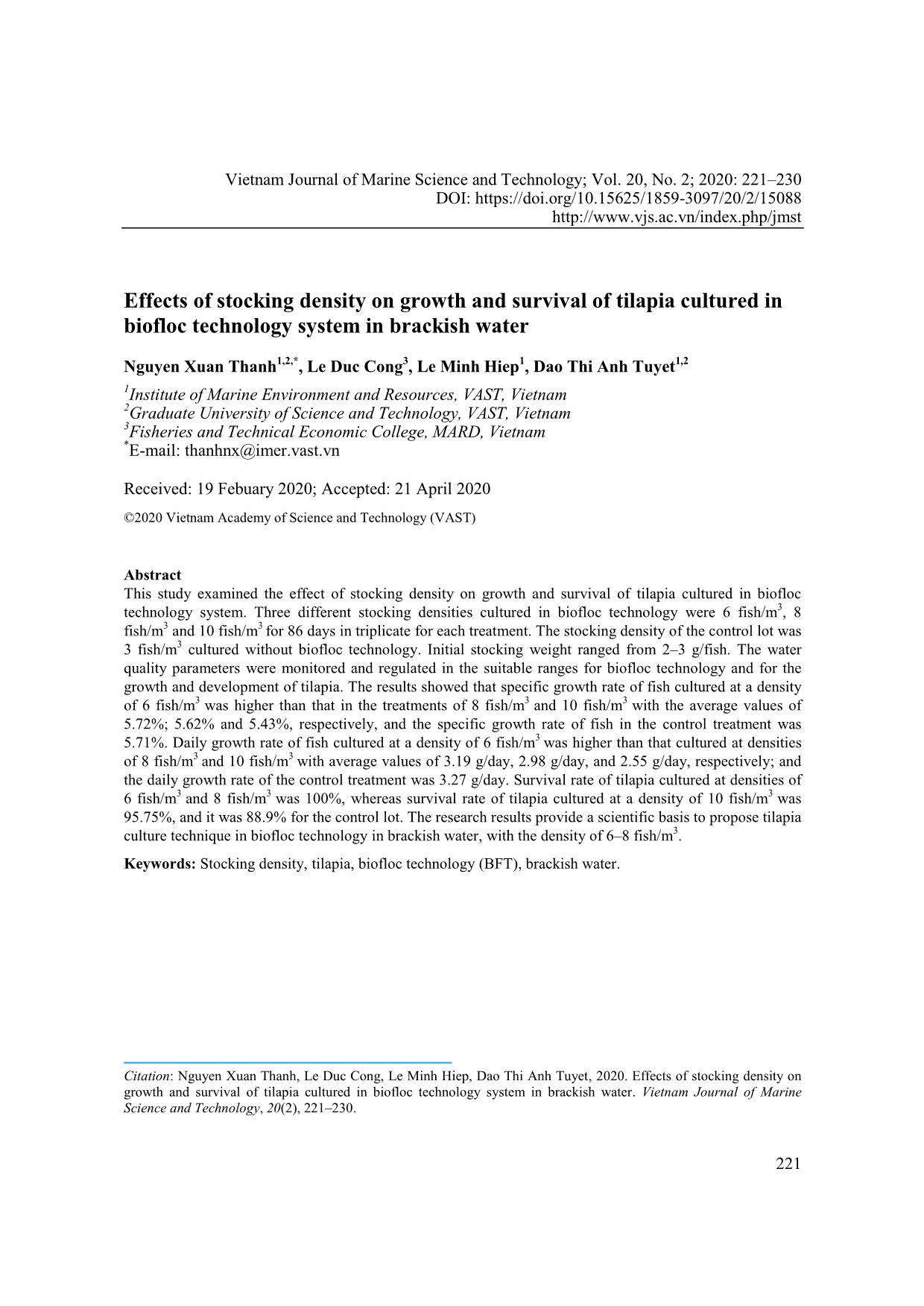
Trang 1
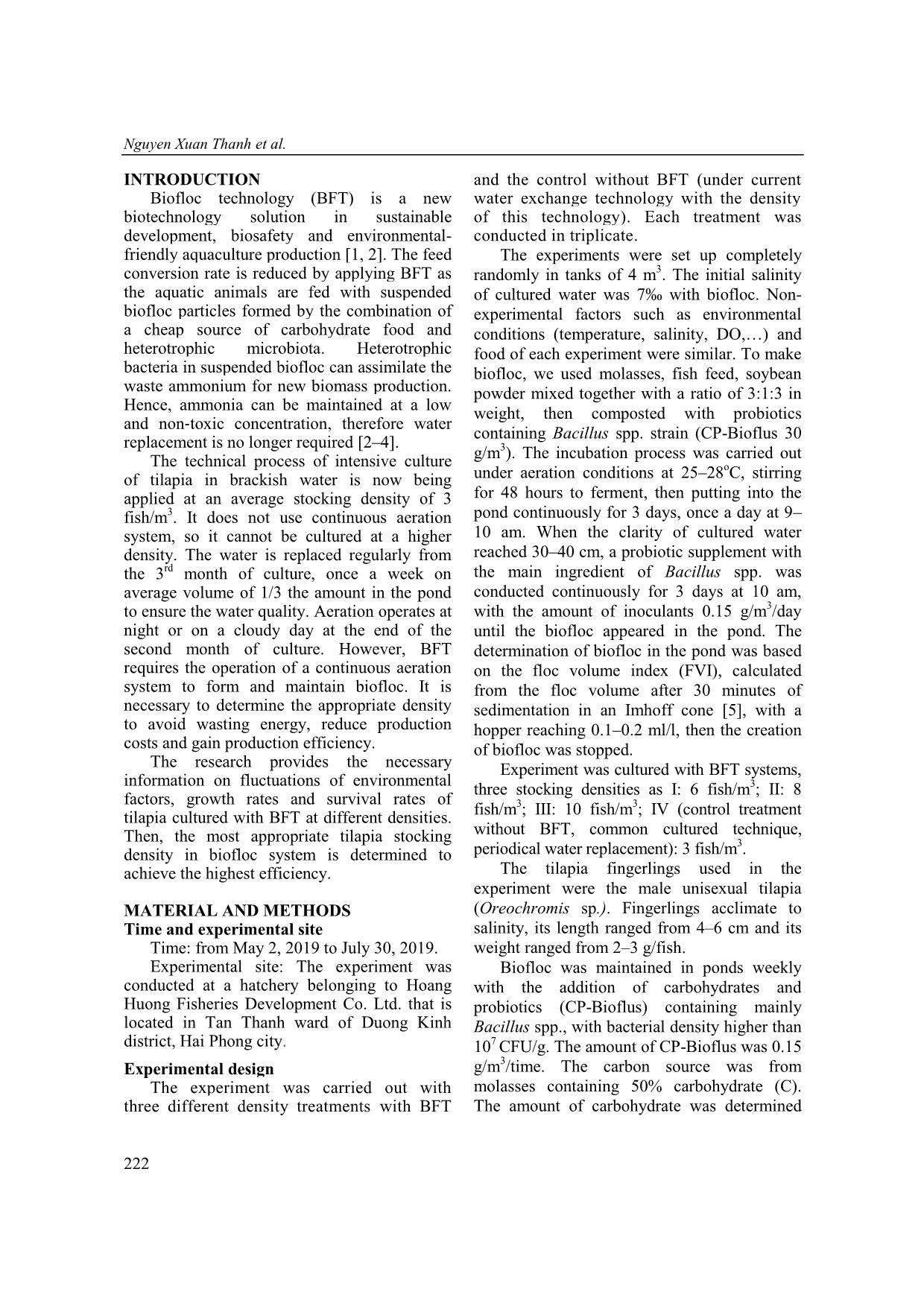
Trang 2
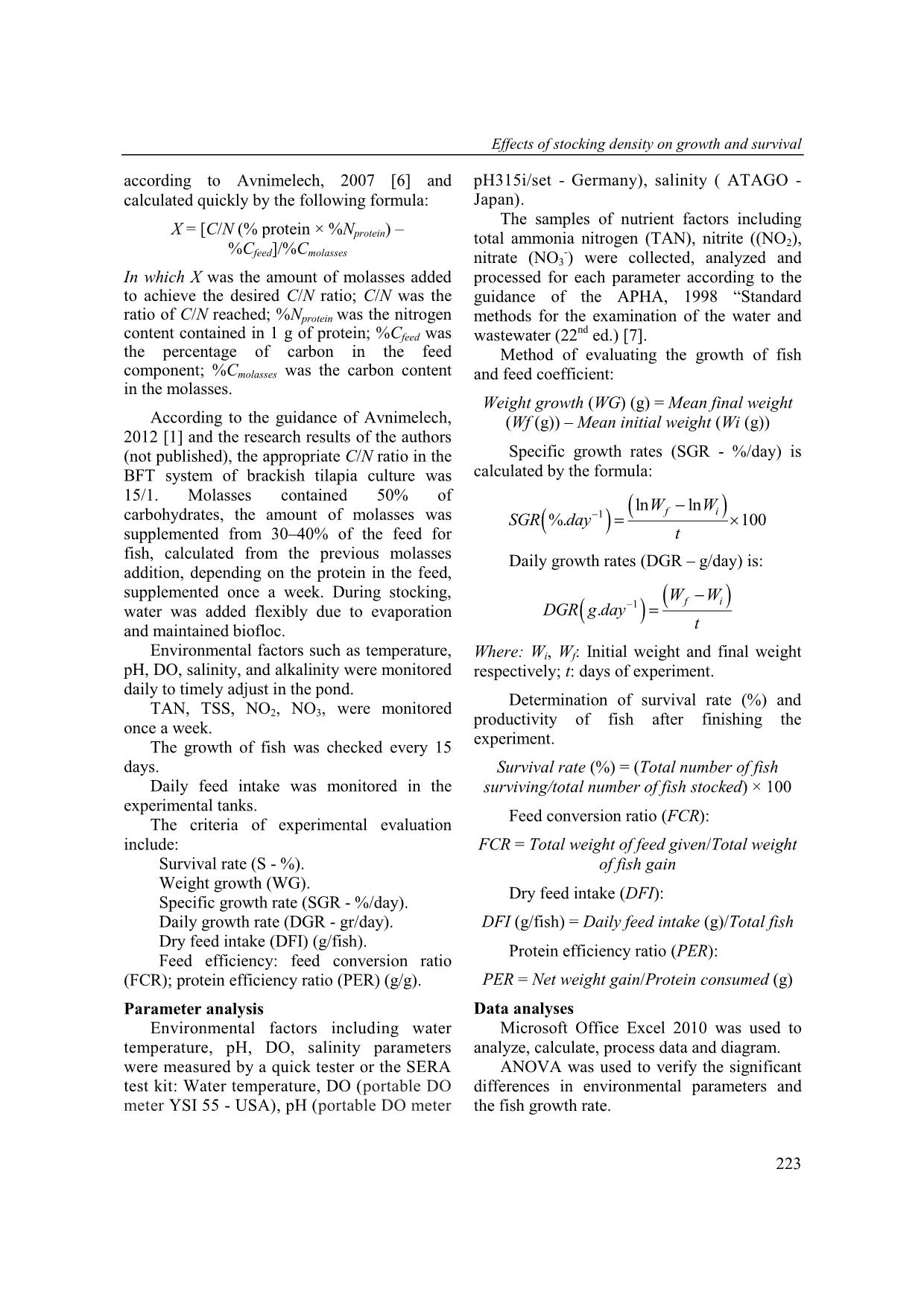
Trang 3
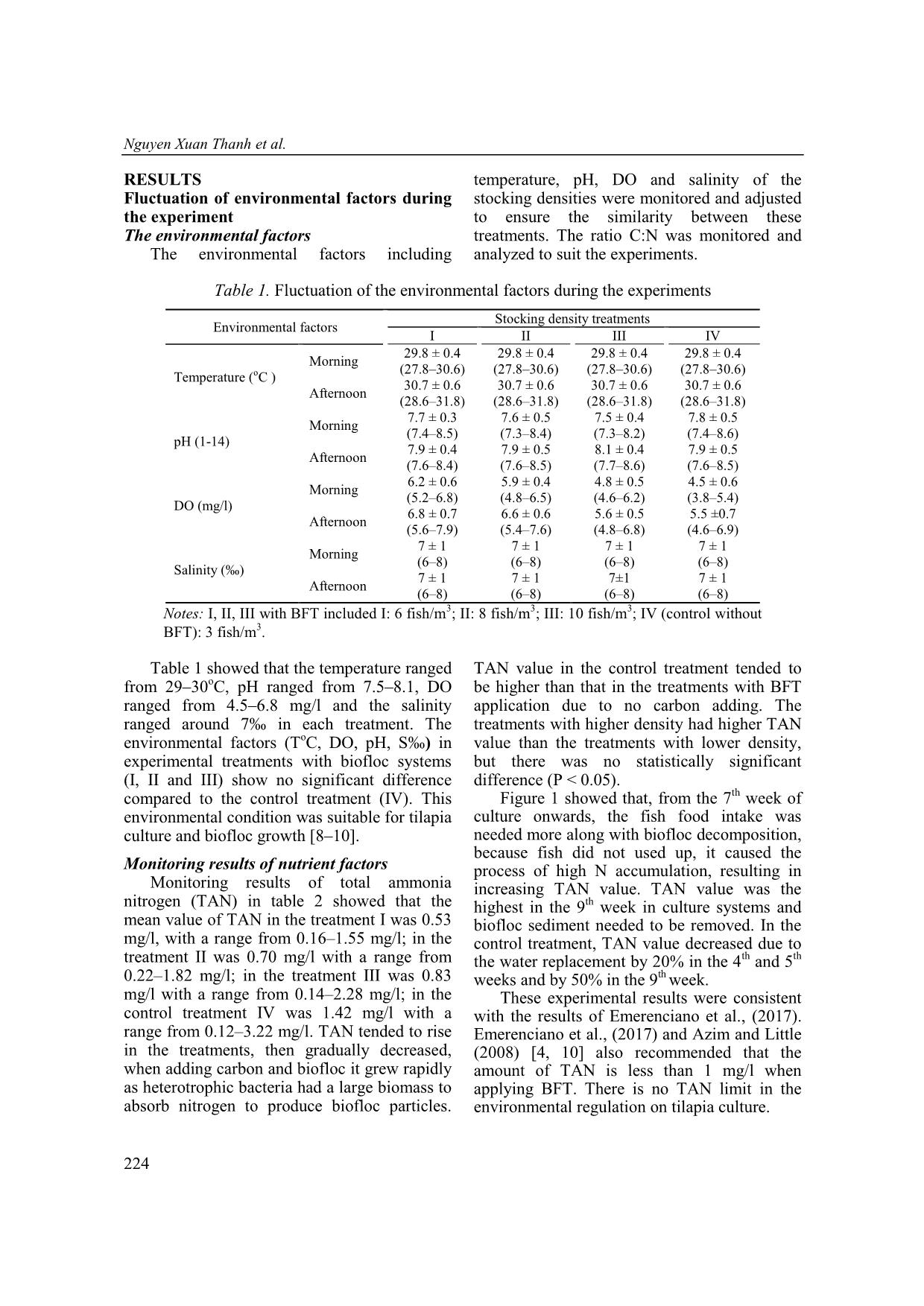
Trang 4
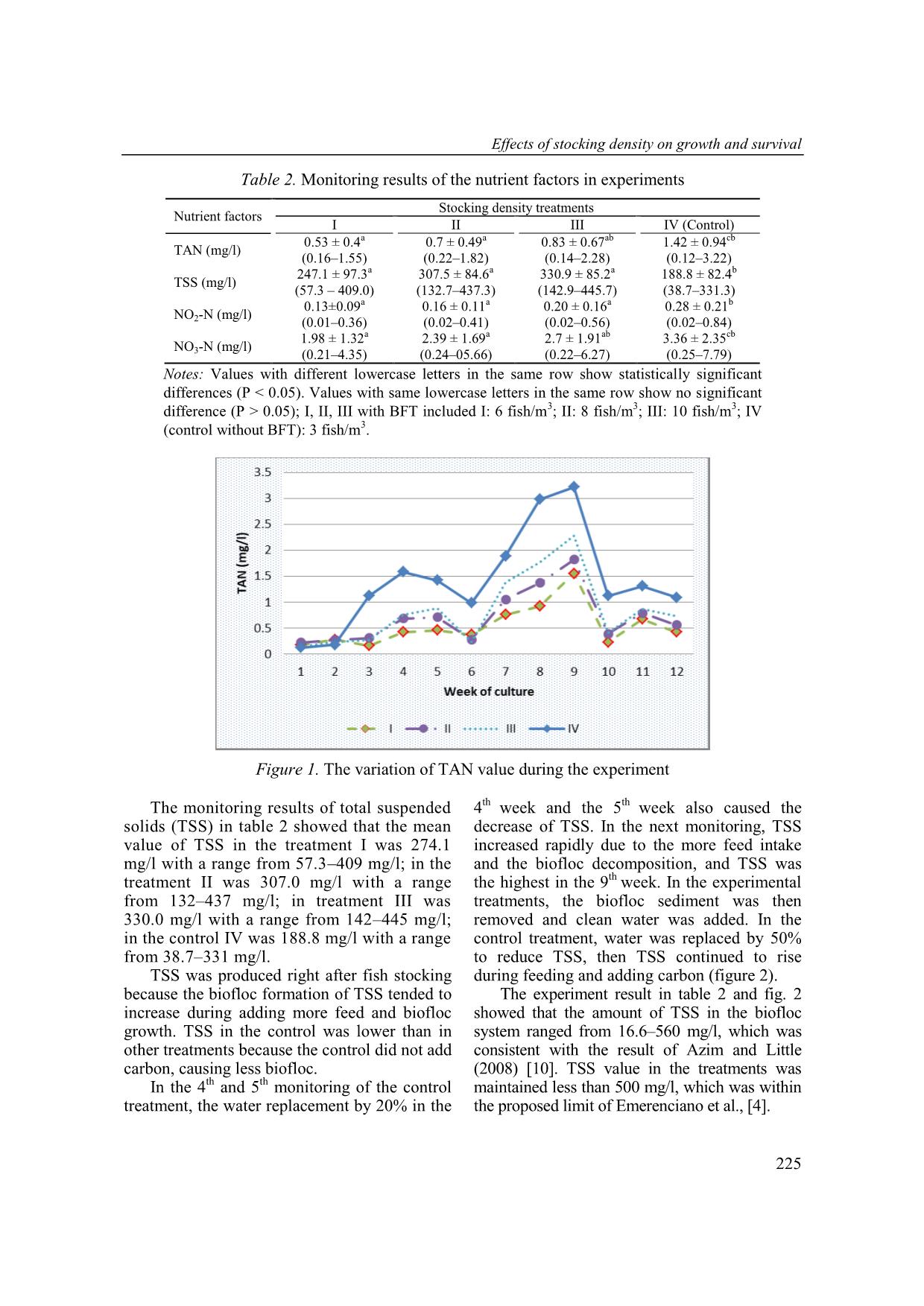
Trang 5
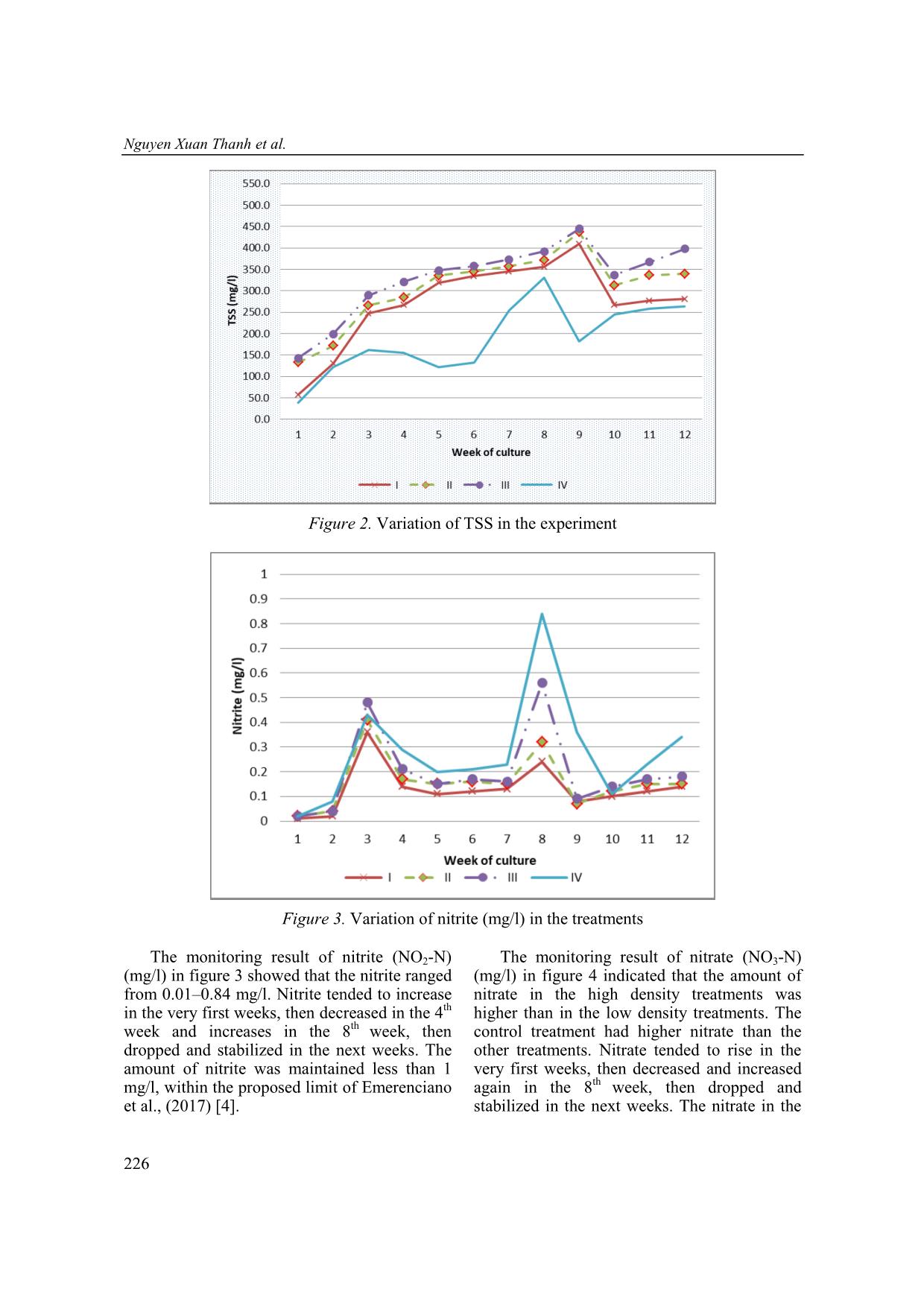
Trang 6
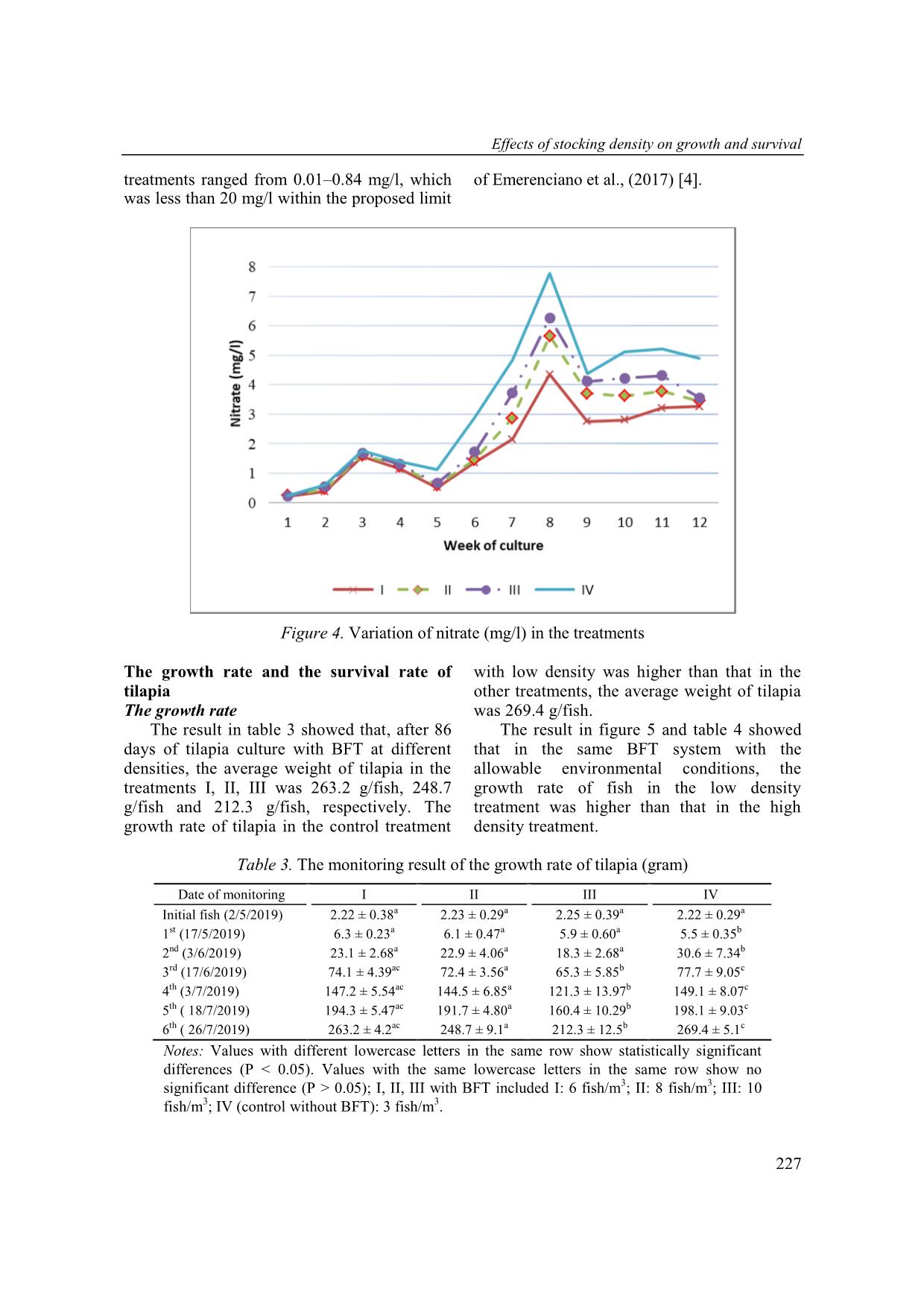
Trang 7
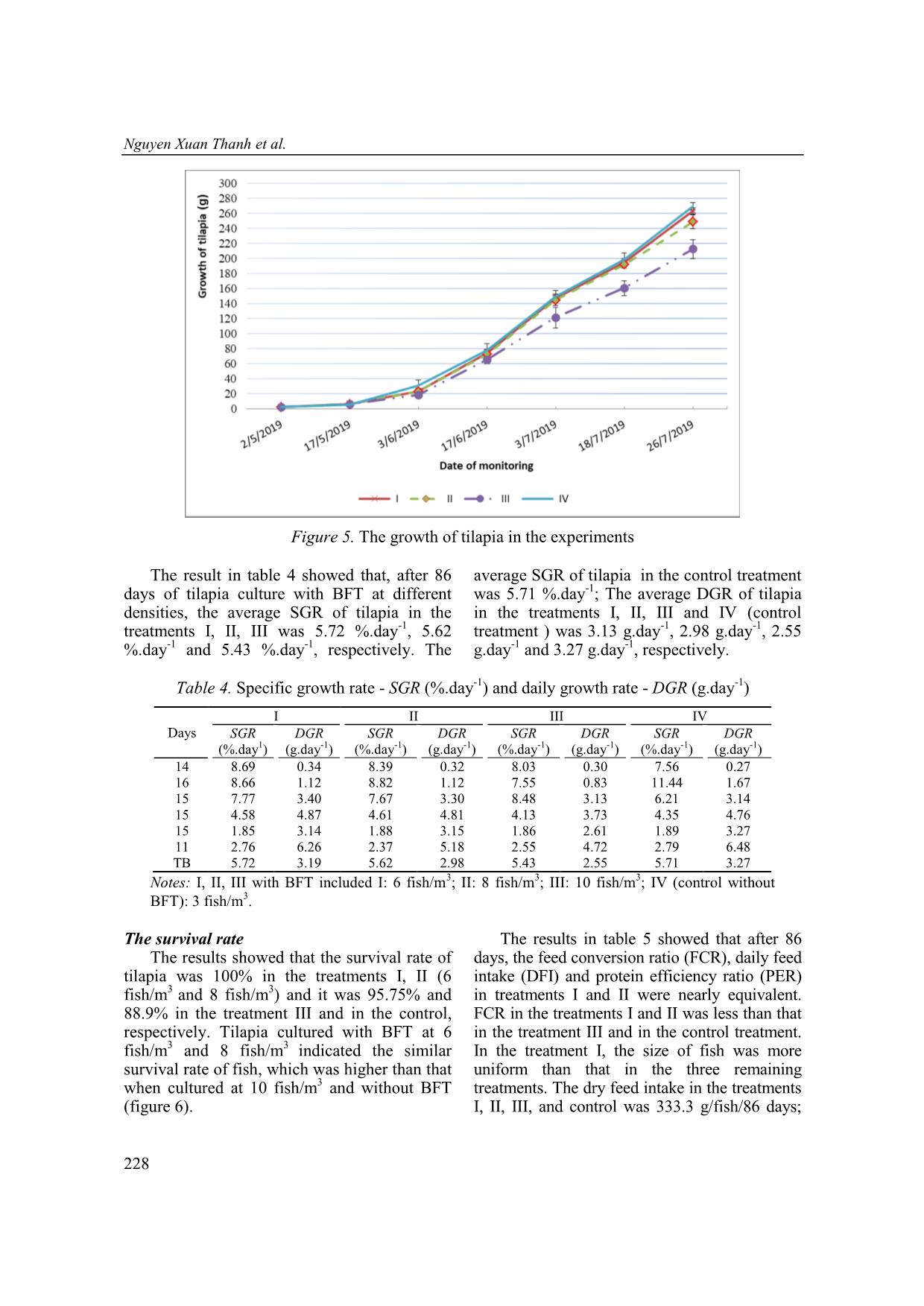
Trang 8
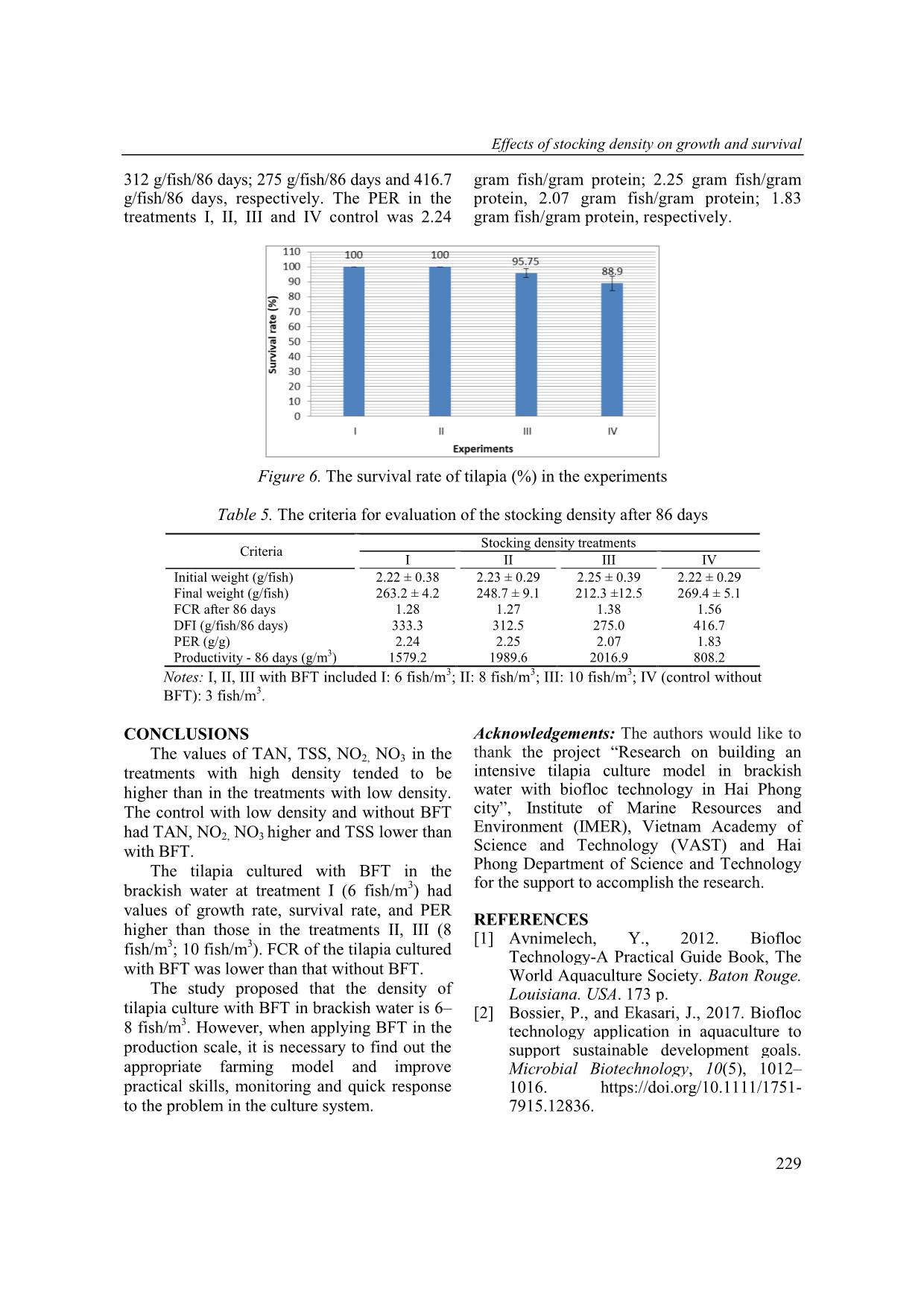
Trang 9
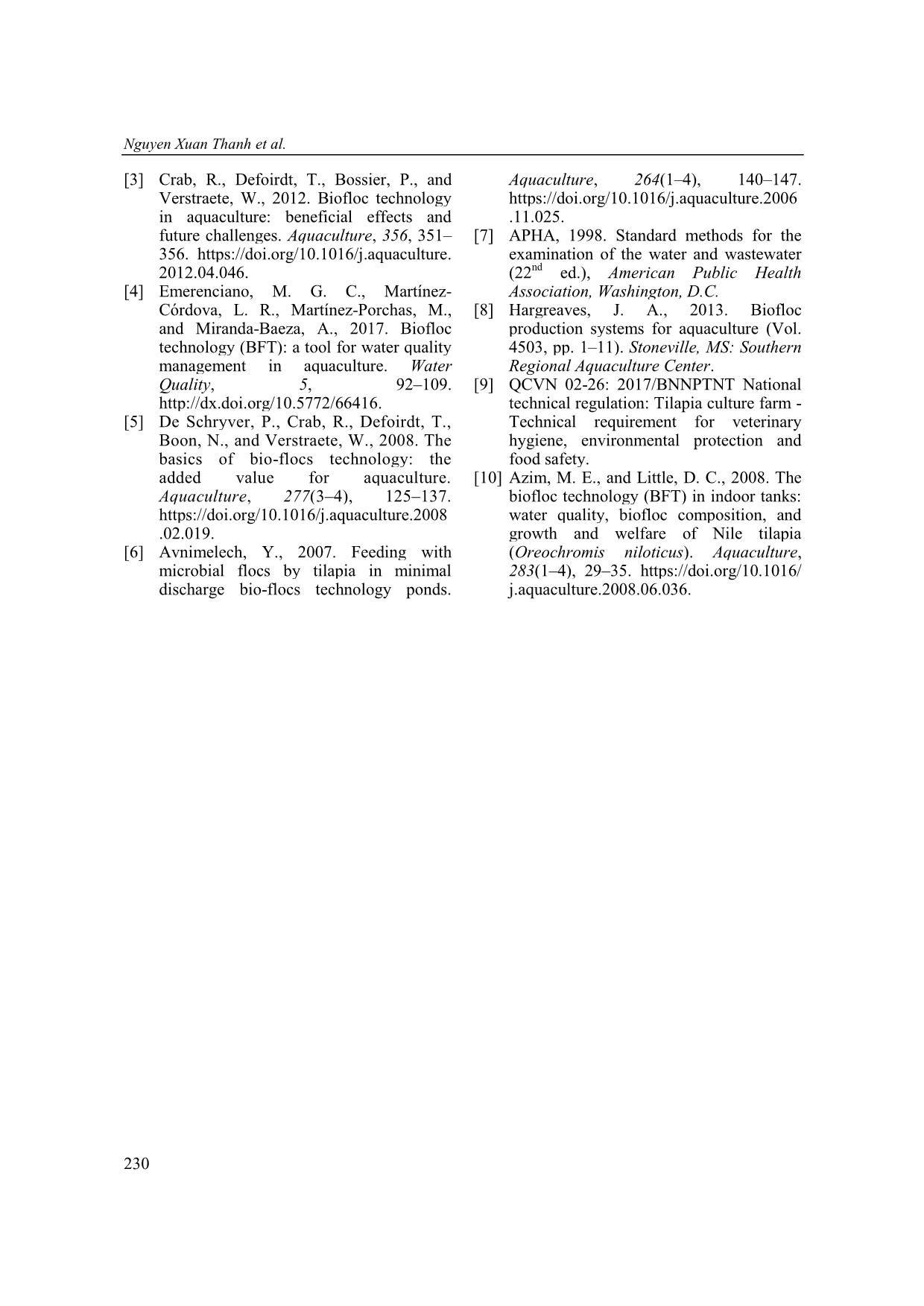
Trang 10
Tóm tắt nội dung tài liệu: Effects of stocking density on growth and survival of tilapia cultured in biofloc technology system in brackish water
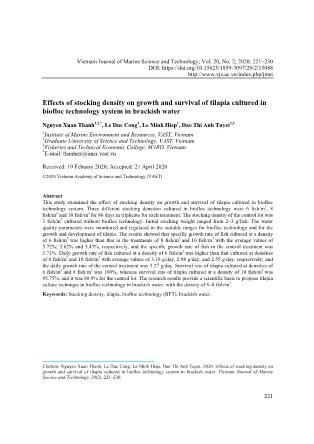
nt. The environmental factors (T o C, DO, pH, S‰) in experimental treatments with biofloc systems (I, II and III) show no significant difference compared to the control treatment (IV). This environmental condition was suitable for tilapia culture and biofloc growth [8–10]. Monitoring results of nutrient factors Monitoring results of total ammonia nitrogen (TAN) in table 2 showed that the mean value of TAN in the treatment I was 0.53 mg/l, with a range from 0.16–1.55 mg/l; in the treatment II was 0.70 mg/l with a range from 0.22–1.82 mg/l; in the treatment III was 0.83 mg/l with a range from 0.14–2.28 mg/l; in the control treatment IV was 1.42 mg/l with a range from 0.12–3.22 mg/l. TAN tended to rise in the treatments, then gradually decreased, when adding carbon and biofloc it grew rapidly as heterotrophic bacteria had a large biomass to absorb nitrogen to produce biofloc particles. TAN value in the control treatment tended to be higher than that in the treatments with BFT application due to no carbon adding. The treatments with higher density had higher TAN value than the treatments with lower density, but there was no statistically significant difference (P < 0.05). Figure 1 showed that, from the 7 th week of culture onwards, the fish food intake was needed more along with biofloc decomposition, because fish did not used up, it caused the process of high N accumulation, resulting in increasing TAN value. TAN value was the highest in the 9 th week in culture systems and biofloc sediment needed to be removed. In the control treatment, TAN value decreased due to the water replacement by 20% in the 4 th and 5 th weeks and by 50% in the 9 th week. These experimental results were consistent with the results of Emerenciano et al., (2017). Emerenciano et al., (2017) and Azim and Little (2008) [4, 10] also recommended that the amount of TAN is less than 1 mg/l when applying BFT. There is no TAN limit in the environmental regulation on tilapia culture. Effects of stocking density on growth and survival 225 Table 2. Monitoring results of the nutrient factors in experiments Nutrient factors Stocking density treatments I II III IV (Control) TAN (mg/l) 0.53 ± 0.4a (0.16–1.55) 0.7 ± 0.49a (0.22–1.82) 0.83 ± 0.67ab (0.14–2.28) 1.42 ± 0.94cb (0.12–3.22) TSS (mg/l) 247.1 ± 97.3a (57.3 – 409.0) 307.5 ± 84.6a (132.7–437.3) 330.9 ± 85.2a (142.9–445.7) 188.8 ± 82.4b (38.7–331.3) NO2-N (mg/l) 0.13±0.09a (0.01–0.36) 0.16 ± 0.11a (0.02–0.41) 0.20 ± 0.16a (0.02–0.56) 0.28 ± 0.21b (0.02–0.84) NO3-N (mg/l) 1.98 ± 1.32a (0.21–4.35) 2.39 ± 1.69a (0.24–05.66) 2.7 ± 1.91ab (0.22–6.27) 3.36 ± 2.35cb (0.25–7.79) Notes: Values with different lowercase letters in the same row show statistically significant differences (P < 0.05). Values with same lowercase letters in the same row show no significant difference (P > 0.05); I, II, III with BFT included I: 6 fish/m 3 ; II: 8 fish/m 3 ; III: 10 fish/m 3 ; IV (control without BFT): 3 fish/m 3 . (control without BFT): 3 fish/m 3 . Figure 1. The variation of TAN value during the experiment The monitoring results of total suspended solids (TSS) in table 2 showed that the mean value of TSS in the treatment I was 274.1 mg/l with a range from 57.3–409 mg/l; in the treatment II was 307.0 mg/l with a range from 132–437 mg/l; in treatment III was 330.0 mg/l with a range from 142–445 mg/l; in the control IV was 188.8 mg/l with a range from 38.7–331 mg/l. TSS was produced right after fish stocking because the biofloc formation of TSS tended to increase during adding more feed and biofloc growth. TSS in the control was lower than in other treatments because the control did not add carbon, causing less biofloc. In the 4 th and 5 th monitoring of the control treatment, the water replacement by 20% in the 4 th week and the 5 th week also caused the decrease of TSS. In the next monitoring, TSS increased rapidly due to the more feed intake and the biofloc decomposition, and TSS was the highest in the 9 th week. In the experimental treatments, the biofloc sediment was then removed and clean water was added. In the control treatment, water was replaced by 50% to reduce TSS, then TSS continued to rise during feeding and adding carbon (figure 2). The experiment result in table 2 and fig. 2 showed that the amount of TSS in the biofloc system ranged from 16.6–560 mg/l, which was consistent with the result of Azim and Little (2008) [10]. TSS value in the treatments was maintained less than 500 mg/l, which was within the proposed limit of Emerenciano et al., [4]. Nguyen Xuan Thanh et al. 226 rise during feeding and adding carbon. Figure 2: Variation of TSS in the experiment The experiment result showed that the amount of TSS in the biofloc system ranged from 16.6- 560 mg/L, which was consistent with the result of Azim and Little (2008) [10]. TSS value in the treatments was maintained less than 500 mg/l, which was within the proposed limit of Emerenciano et al., (2017) [4]. Figure 2. Variation of TSS in the experiment Figure 3: Variation of nitrite (mg/l) in the treatments Figure 3. Variation of nitrite (mg/l) in the treatments The monitoring result of nitrite (NO2-N) (mg/l) in figure 3 showed that the nitrite ranged from 0.01–0.84 mg/l. Nitrite tended to increase in the very first weeks, then decreased in the 4 th week and increases in the 8 th week, then dropped and stabilized in the next weeks. The amount of nitrite was maintained less than 1 mg/l, within the proposed limit of Emerenciano et al., (2017) [4]. The monitoring result of nitrate (NO3-N) (mg/l) in figure 4 indicated that the amount of nitrate in the high density treatments was higher than in the low density treatments. The control treatment had higher nitrate than the other treatments. Nitrate tended to rise in the very first weeks, then decreased and increased again in the 8 th week, then dropped and stabilized in the next weeks. The nitrate in the Effects of stocking density on growth and survival 227 treatments ranged from 0.01–0.84 mg/l, which was less than 20 mg/l within the proposed limit of Emerenciano et al., (2017) [4]. Figure 4: Variation of nitrate (mg/l) in the treatments Figur 4. Variation of nitrate (mg/l) in the treatments The growth rate and the survival rate of tilapia The growth rate The result in table 3 showed that, after 86 days of tilapia culture with BFT at different densities, the average weight of tilapia in the treatments I, II, III was 263.2 g/fish, 248.7 g/fish and 212.3 g/fish, respectively. The growth rate of tilapia in the control treatment with low density was higher than that in the other treatments, the average weight of tilapia was 269.4 g/fish. The result in figure 5 and table 4 showed that in the same BFT system with the allowable environmental conditions, the growth rate of fish in the low density treatment was higher than that in the high density treatment. Table 3. The monitoring result of the growth rate of tilapia (gram) Date of monitoring I II III IV Initial fish (2/5/2019) 2.22 ± 0.38a 2.23 ± 0.29a 2.25 ± 0.39a 2.22 ± 0.29a 1st (17/5/2019) 6.3 ± 0.23a 6.1 ± 0.47a 5.9 ± 0.60a 5.5 ± 0.35b 2nd (3/6/2019) 23.1 ± 2.68a 22.9 ± 4.06a 18.3 ± 2.68a 30.6 ± 7.34b 3rd (17/6/2019) 74.1 ± 4.39ac 72.4 ± 3.56a 65.3 ± 5.85b 77.7 ± 9.05c 4th (3/7/2019) 147.2 ± 5.54ac 144.5 ± 6.85a 121.3 ± 13.97b 149.1 ± 8.07c 5th ( 18/7/2019) 194.3 ± 5.47ac 191.7 ± 4.80a 160.4 ± 10.29b 198.1 ± 9.03c 6th ( 26/7/2019) 263.2 ± 4.2ac 248.7 ± 9.1a 212.3 ± 12.5b 269.4 ± 5.1c Notes: Values with different lowercase letters in the same row show statistically significant differences (P < 0.05). Values with the same lowercase letters in the same row show no significant difference (P > 0.05); I, II, III with BFT included I: 6 fish/m 3 ; II: 8 fish/m 3 ; III: 10 fish/m 3 ; IV (control without BFT): 3 fish/m 3 . Nguyen Xuan Thanh et al. 228 Figure 5. The growth of tilapia in the experiments The result in table 4 showed that, after 86 days of tilapia culture with BFT at different densities, the average SGR of tilapia in the treatments I, II, III was 5.72 %.day -1 , 5.62 %.day -1 and 5.43 %.day -1 , respectively. The average SGR of tilapia in the control treatment was 5.71 %.day -1 ; The average DGR of tilapia in the treatments I, II, III and IV (control treatment ) was 3.13 g.day -1 , 2.98 g.day -1 , 2.55 g.day -1 and 3.27 g.day -1 , respectively. Table 4. Specific growth rate - SGR (%.day -1 ) and daily growth rate - DGR (g.day -1 ) Days I II III IV SGR (%.day1) DGR (g.day-1) SGR (%.day-1) DGR (g.day-1) SGR (%.day-1) DGR (g.day-1) SGR (%.day-1) DGR (g.day-1) 14 8.69 0.34 8.39 0.32 8.03 0.30 7.56 0.27 16 8.66 1.12 8.82 1.12 7.55 0.83 11.44 1.67 15 7.77 3.40 7.67 3.30 8.48 3.13 6.21 3.14 15 4.58 4.87 4.61 4.81 4.13 3.73 4.35 4.76 15 1.85 3.14 1.88 3.15 1.86 2.61 1.89 3.27 11 2.76 6.26 2.37 5.18 2.55 4.72 2.79 6.48 TB 5.72 3.19 5.62 2.98 5.43 2.55 5.71 3.27 Notes: I, II, III with BFT included I: 6 fish/m 3 ; II: 8 fish/m 3 ; III: 10 fish/m 3 ; IV (control without BFT): 3 fish/m 3 . The survival rate The results showed that the survival rate of tilapia was 100% in the treatments I, II (6 fish/m 3 and 8 fish/m 3 ) and it was 95.75% and 88.9% in the treatment III and in the control, respectively. Tilapia cultured with BFT at 6 fish/m 3 and 8 fish/m 3 indicated the similar survival rate of fish, which was higher than that when cultured at 10 fish/m 3 and without BFT (figure 6). The results in table 5 showed that after 86 days, the feed conversion ratio (FCR), daily feed intake (DFI) and protein efficiency ratio (PER) in treatments I and II were nearly equivalent. FCR in the treatments I and II was less than that in the treatment III and in the control treatment. In the treatment I, the size of fish was more uniform than that in the three remaining treatments. The dry feed intake in the treatments I, II, III, and control was 333.3 g/fish/86 days; Effects of stocking density on growth and survival 229 312 g/fish/86 days; 275 g/fish/86 days and 416.7 g/fish/86 days, respectively. The PER in the treatments I, II, III and IV control was 2.24 gram fish/gram protein; 2.25 gram fish/gram protein, 2.07 gram fish/gram protein; 1.83 gram fish/gram protein, respectively. higher than that when cultured at 10 fish/m 3 and without BFT (Fig. 6). Figure 6: The survival rate of tilapia (%) in the experiments Figure 6. The survival rate tilapia (%) in th experiments Table 5. The criteria for evaluation of the stocking density after 86 days Criteria Stocking density treatments I II III IV Initial weight (g/fish) 2.22 ± 0.38 2.23 ± 0.29 2.25 ± 0.39 2.22 ± 0.29 Final weight (g/fish) 263.2 ± 4.2 248.7 ± 9.1 212.3 ±12.5 269.4 ± 5.1 FCR after 86 days 1.28 1.27 1.38 1.56 DFI (g/fish/86 days) 333.3 312.5 275.0 416.7 PER (g/g) 2.24 2.25 2.07 1.83 Productivity - 86 days (g/m3) 1579.2 1989.6 2016.9 808.2 Notes: I, II, III with BFT included I: 6 fish/m 3 ; II: 8 fish/m 3 ; III: 10 fish/m 3 ; IV (control without BFT): 3 fish/m 3 . CONCLUSIONS The values of TAN, TSS, NO2, NO3 in the treatments with high density tended to be higher than in the treatments with low density. The control with low density and without BFT had TAN, NO2, NO3 higher and TSS lower than with BFT. The tilapia cultured with BFT in the brackish water at treatment I (6 fish/m 3 ) had values of growth rate, survival rate, and PER higher than those in the treatments II, III (8 fish/m 3 ; 10 fish/m 3 ). FCR of the tilapia cultured with BFT was lower than that without BFT. The study proposed that the density of tilapia culture with BFT in brackish water is 6– 8 fish/m 3 . However, when applying BFT in the production scale, it is necessary to find out the appropriate farming model and improve practical skills, monitoring and quick response to the problem in the culture system. Acknowledgements: The authors would like to thank the project “Research on building an intensive tilapia culture model in brackish water with biofloc technology in Hai Phong city”, Institute of Marine Resources and Environment (IMER), Vietnam Academy of Science and Technology (VAST) and Hai Phong Department of Science and Technology for the support to accomplish the research. REFERENCES [1] Avnimelech, Y., 2012. Biofloc Technology-A Practical Guide Book, The World Aquaculture Society. Baton Rouge. Louisiana. USA. 173 p. [2] Bossier, P., and Ekasari, J., 2017. Biofloc technology application in aquaculture to support sustainable development goals. Microbial Biotechnology, 10(5), 1012– 1016. https://doi.org/10.1111/1751- 7915.12836. Nguyen Xuan Thanh et al. 230 [3] Crab, R., Defoirdt, T., Bossier, P., and Verstraete, W., 2012. Biofloc technology in aquaculture: beneficial effects and future challenges. Aquaculture, 356, 351– 356. https://doi.org/10.1016/j.aquaculture. 2012.04.046. [4] Emerenciano, M. G. C., Martínez- Córdova, L. R., Martínez-Porchas, M., and Miranda-Baeza, A., 2017. Biofloc technology (BFT): a tool for water quality management in aquaculture. Water Quality, 5, 92–109. [5] De Schryver, P., Crab, R., Defoirdt, T., Boon, N., and Verstraete, W., 2008. The basics of bio-flocs technology: the added value for aquaculture. Aquaculture, 277(3–4), 125–137. https://doi.org/10.1016/j.aquaculture.2008 .02.019. [6] Avnimelech, Y., 2007. Feeding with microbial flocs by tilapia in minimal discharge bio-flocs technology ponds. Aquaculture, 264(1–4), 140–147. https://doi.org/10.1016/j.aquaculture.2006 .11.025. [7] APHA, 1998. Standard methods for the examination of the water and wastewater (22 nd ed.), American Public Health Association, Washington, D.C. [8] Hargreaves, J. A., 2013. Biofloc production systems for aquaculture (Vol. 4503, pp. 1–11). Stoneville, MS: Southern Regional Aquaculture Center. [9] QCVN 02-26: 2017/BNNPTNT National technical regulation: Tilapia culture farm - Technical requirement for veterinary hygiene, environmental protection and food safety. [10] Azim, M. E., and Little, D. C., 2008. The biofloc technology (BFT) in indoor tanks: water quality, biofloc composition, and growth and welfare of Nile tilapia (Oreochromis niloticus). Aquaculture, 283(1–4), 29–35. https://doi.org/10.1016/ j.aquaculture.2008.06.036.
File đính kèm:
 effects_of_stocking_density_on_growth_and_survival_of_tilapi.pdf
effects_of_stocking_density_on_growth_and_survival_of_tilapi.pdf

